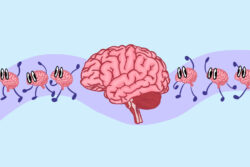As science continues to progress faster than ever, the line separating imagination and possibility stretches thinner. One of the more recent scientific breakthroughs within the past decade is the emergence of human brain organoids. These are small clusters of neural tissue models generated from stem cells and are often referred to as “minibrains.” It may seem like these are just clumps of cells in a dish. However, these are three-dimensional structures that share similarities to the way a brain develops in the early stages of growth.
Scientists use human pluripotent stem cells, derived from adult tissue, primarily from skin or blood, as a base to create brain organoids. What seems unreal, and the reason why this particular variant is highly favored, is its ability to replicate any cell type in the body. As they begin to grow, the cells are transferred into biomimetic gel, a soft, Jell-O-like material that imitates the texture of the brain’s natural environment. The word biomimetic means “copying life,” so it interacts with cells and moves like real tissue to support growth. This allows for the brain organoids to self-arrange into a structure that resembles the wrinkled tissue of the cerebral cortex — the outer layers of the brain that handles things like thinking and sensing.

BETHANY CLOSE / DAILY NEXUS
Scientists have discovered that organoids possess both the molecular and cellular characteristics of a developing brain. As they mature, they start to show signs of electrical activity or patterns of signaling between neurons that are seen in actual human brains.
This opens up exciting new possibilities for studying brain function and neurological diseases in ways humans haven’t thought of before. These experiments pose questions about what it means to be aware, feel and exist. Could these brain organoids be capable of a conscious experience?
In 2019, researchers at UC San Diego successfully formed brain organoids that created rhythmic, neural pulses on their own. These signals were sparked by two principal neurotransmitters: gamma-aminobutyric acid (GABA), which keeps the brain circuits balanced (affecting how humans control movement and process sound), and glutamate, a chemical messenger that plays a key role in learning and memory by exciting neurons. Starting with simple, regular bursts of energy, it shifted to a more unpredictable pattern that manifested across different regions of the brain. This means that multiple areas of the brain were involved in neuronal communication, indicating that they’re working together, likely in response to a transition in mental state, such as a shift into problem-solving mode.
The electroencephalogram (EEG), a test of measuring electrical activity in the brain, showed that the patterns observed in premature infants resemble the local field potentials (LFPs) recorded in the organoids. The similarity suggests that they may be capable of mimicking the earliest functional states of the brain. With scientists studying brain development in vitro, meaning outside of the body, it offers clues to where awareness comes from.
By observing early patterns of brain signaling, many can start to wonder: How does this reveal how consciousness begins?
Consciousness is often thought of as being alive and constantly experiencing the world by thinking and feeling through the will to make authentic decisions. Yet, even with advanced technology and innovative brain scans, it’s still difficult to define. Theories speculate that it involves how the different areas of the brain communicate information — that it’s not about having functioning cells but about how they talk to build an experience across the folded landscape of the brain.
It is also a behavioral algorithm shaped by evolution to guide action through the senses. One theory suggests that conscious thought can emerge when information is available across the various brain regions. When neural impulses are broadly distributed, it becomes easier for cognitive systems to assess information.
The electrical signals that organoids produce show their organized networks that are built to carry thought. Although they lack the full anatomical structure of a brain, their ability to organize itself shows potential. This can help scientists better understand where the conscious experience starts to take shape. If brain organoids continue to grow and form these structured networks, it’s possible they may reach a level of deep understanding.
Other experiments depicted how brain organoids have the ability to respond to an external stimulus, such as light. Researchers use a technique called optogenetics, a process of adding light-sensitive proteins to organoids as a way to control gene expression. When they shine a light on them, the proteins activate certain cells, allowing them to see how neural circuits react. This shows how the communication pathways in the brain will respond to outside signals. Some even formed optic cups, an early eye-like structure, showing that they’re capable of developing sensory perception.
These studies change the question from “Are they conscious?” to “What experiences are they capable of?” There may be something more beyond just electrical signals.




















